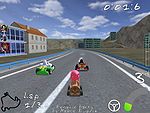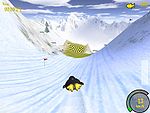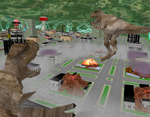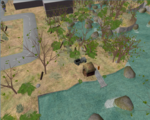Steve Baker
| Project(s): | |
|---|---|
| Team(s): | TuxKart, Lemur of Lima, Unification - with Oliver Baker; freeglut - Andreas Umbach and Pawel W. Olszta[10] |
| Used license(s): | GNU LGPL[2], GPL[4], X-Consortium license[11], ???[10] |
| Position(s): | Programmer |
Steve Baker is the main developer of PLIB and Tuxedo T. Penguin: A Quest for Herring, and a co-developer of TuxKart with his son, Oliver Baker. He is of British heritage but currently lives and works in Texas. He attended the University of Kent. He works for Total Immersion in Austin, though he has made many free software games.[12] He is also the progenitor of the recurring character Gown, the original female equivalent to Tux (as opposed to the more recent Penny). He is active on Wikipedia[13], particularly on the "Tux" article.[14] He is also one of the earliest users of 3D graphics in free software games, coming even before the Quake and the like source releases greatly expanded 3D free gaming lists.[15] He also contributed to the book Linux Game Programming alongside Mark Collins and Martin Donlin for Prima Games.
Tuxedo T. Penguin: A Quest for Herring[edit]
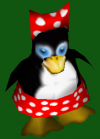
Inspired by the Linux kernel mascot Tux, Steve Baker started to work on a 3D game featuring him in 1998, a feat which he claims had yet to be done before, though he doubts that his was the fist Tux game.[16] He has also claimed that it was the first 3D graphics game designed for Linux.[17]
The 3D Tux was generated by digitizing Tux's profile from Larry Ewing's painting, that was then rotated through 360 degrees to generate a volume of revolution. The flippers and feet were hand-built and the beak is a cone which has been squashed from end-to-end and from top to bottom. The texture map also derives from Ewings's original painting, but he had to fill in the background with solid black, remove the feet and turn the beak into separate texture map. Since he needed to use Tux in his 3D game, it was necessary to reduce the resolution of the image so that it would not consume too much texture memory. The version in the game has better feet, a head that turns, and a beak that opens and shuts. It also sits in the same pose as in Ewings's painting.[18]
The first offical announcement A Quest for Herring (also known as "Tux_AQFH") was on Slashdot on May 6, 1999. The game received 50,000 downloads within 24 hours of the Slashdot announcement and has been subsequently ported to BSD, Windows, Mac, SunOS and Irix from its original Linux platform.[19] He says that the game was an important learning step but "it's easier to toss it out and write something new than to fix it's problems." As such the game is no longer supported.[20]
External links[edit]
TuxKart[edit]
His second major game was TuxKart which he created alongside his son Oliver Baker. Oliver designed some of the race tracks, most notably one that is a recreation of his fifth grade math class, which was created because they gave a presentation to that class and wanted to surprise them with a detailed model of the actual classroom the presentation was being given in.[21] After he and Oliver completed their work they considered the project completed.
However the Linux Game Tome Game of the Month team decided to host a month of intensive effort to improve the game. According to Steve Baker it "sounded like a good idea - but in fact they totally screwed up the entire thing and ended up with a game that wasn't even playable. I backed out all of their changes and restored the project to it's original state."[22] Meanwhile the Game of the Month team forked the original code into a short lived project called SuperTuxKart. In June 2006 Baker was approached by parties interested in trying to revive SuperTuxKart. Baker did not participate because "I have other OpenSource projects that matter more to me now" but did note "I wish them well - TuxKart is long overdue for a polish since graphics cards are about 1,000 times faster than they were when TuxKart was written!"[23] This project is now responsible for the modern version of SuperTuxKart.
He also worked on Tux Racer by providing the development team heavily with assistance such as OpenGL advice, he is said to have been upset when it went proptrietary.[24] He has also noted people's confusion between that game and his own TuxKart with notes saying "people confuse my game (TuxKart) with TuxRacer all the time. It would have been better if TuxRacer had been given a clearer name (Tux Downhill Racer or something)."[25]
PLIB and freeglut[edit]
botZilla[edit]
Trieres[edit]
Trieres is a project to create a simulation computer game to simulate the kinds of large-scale battles the Trieres ships of the Ancient Greeks and of the Ancient Mediterranean were known to have engaged in. This is to be based on historical data that has been painstakingly collected through various sources[26], and based on observations of a modern recreation of the ships.[27] The game features Steve Baker's trademark skills in 3D graphics.[28] The project was started by him after reading "The Athenian Trireme", which provided most of the historical information being used for the project.[29]
Lemur of Lima[edit]
On the fourth of June 2006 he mentioned that he and Oliver were working on their next computer game collaboration - Lemur of Lima, a free 3D game about lemurs.[30] About the game his father mentioned "yes, we know Lemurs come from Madagascar - but there's a plot point here!" He mentioned that it would feature a cameo part for Tux, the usual character of his games, and that it would be openly developed once "it gets to a point where we've stopped having too much fun writing it and could use some help!"[31] The project was latter uploaded onto his wiki on October 24, 2007, mentioning that it was a Prince of Persia-like game[32], as well as a screenshot gallery of both then modern and historic screenshots, which were again edited on December 3, 2007. This is the last time the project page has been edited.[33] The wiki upload also elaborated the plot, mentioning that the protagonist is a ring-tailed lemur who was being sent home to Madagascar when a spelling mistake on his shipping label sent him to Lima, Peru instead. From there the player has to try and find a way home and defeat the evil LOCon corporation and save the rain forest.[34] A video of a high detail 3D walking animation of what appears to be the protagonist is available from Oliver's online portfolio.[35]
On February 7, 2008 they announced Unification, a game to testbed work on the Lemur of Lima engine. They say they are trying to make everything scriptable and flexible so that they will end up with a completely general game engine at the end of the process. The game is said to be based on Mario Galaxies and is mostly being developed to create physics forces for the engine. The game currently stars Tux, though a new character, possibly a cartoon Albert Einstein is planned.[36] Like the Lemur of Lima, they also released a screenshot gallery.[37]
References[edit]
- ↑ AQGH project page
- ↑ 2.0 2.1 http://plib.sourceforge.net/license.html
- ↑ 3.0 3.1 http://www.sjbaker.org/steve/
- ↑ 4.0 4.1 http://tuxkart.sourceforge.net/license.html
- ↑ Steve Baker on TuxRacer
- ↑ http://botzilla.sourceforge.net/
- ↑ freeglut website
- ↑ Trieres website
- ↑ Lemur of Lima project page
- ↑ 10.0 10.1 http://packages.debian.org/changelogs/pool/main/f/freeglut/freeglut_2.4.0-5/freeglut3.copyright
- ↑ freeglut website
- ↑ Steve Baker's Wikipedia user page
- ↑ Steve's Wikipedia Entries
- ↑ Wikipedia - Talk:Tux
- ↑ AQFH project page
- ↑ Steve Baker on the history of Tux_AQFH
- ↑ A Quest for Herring on Steve Baker's wiki
- ↑ The History of Tux the Linux Penguin - Tux in 3D by Steve Baker
- ↑ Steve Baker on the history of Tux_AQFH
- ↑ Steve Baker on the history of Tux_AQFH
- ↑ Steve Baker on the history of TuxKart
- ↑ Steve Baker on the history of TuxKart
- ↑ Steve Baker on the history of TuxKart
- ↑ Steve Baker on Tux Racer
- ↑ Steve Baker on TuxKart and Tux Racer
- ↑ Triereis website - History
- ↑ Triereis website
- ↑ Triereis website - Screenshots
- ↑ Triereis website - Links
- ↑ Steve Baker on Lemur of Lima
- ↑ Steve Baker on Lemur of Lima
- ↑ Lemur of Lima project page
- ↑ LoL Screen Shots
- ↑ Lemur of Lima project page
- ↑ Oliver Baker's Portfolio
- ↑ Unification project page
- ↑ Unification screenshots

